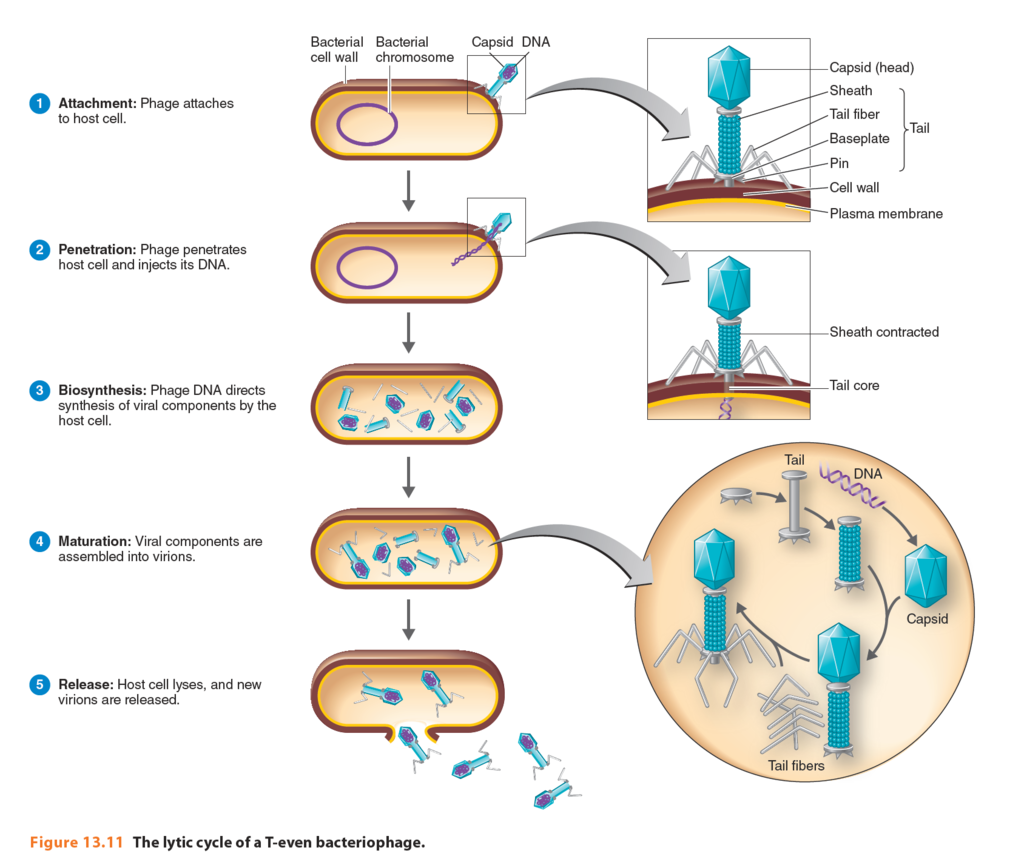Once Inside the Host Cell Phage Dna
It subverts the cell machinery to the exclusive manufacture of nucleic acid and protein molecules needed for the assembly of hundreds of new phage. Phage DNA integrated into host cell genome.
Environmental stressors such as starvation or exposure to toxic chemicals may cause the prophage to excise and enter the lytic cycle.
. Characteristic Virus Cell Structure DNA or RNA core capsid Cell membrane cytoplasm. The lambda phages were one of the earliest model systems for the study of DNA and genes Davidson and Szyblaski 1971. Attachment penetration transcription biosynthesis maturation and lysis.
In the lytic cycle of phage replication. SARS-CoV-2 is the virus that causes COVID-19. The lambda virion chromosome was also among the first.
Biosynthesis Once inside the cell phage DNA redirects host cell metabolism. Once inside the host cell phage DNA. All of the choice are correct.
Once inside the host the viruses take over the cells machinery subverting it to make new phage particles. Biosynthesis - Once inside the cell phage DNA redirects host cell metabolism. It does not matter which bacterial species you grow a particular phage in because bacteriophages are not host-specific.
Once inside the host cell the DNA has to compete with the host DNA for the transcription and translation machinery of the cell. Phage nucleic acid is replicated and phage genes are expressed making new phage protein and lysing the host cell. The virus uses its _________ to attach to _______ on the surface of cells.
Cosmids are the vectors possessing the characteristics of both plasmid and bacteriophage. SARS MERS ACE2 SPIKE DNA RNA. B the tail acts as a hypodermic needle injecting the phage DNA into the cell.
C the protein fibers digest a hole in the cell wall. The six stages are. Following the classical viral reproductive strategies once the phage inserts their nucleic acid into the bacteriums cytoplasm the host cellular machinery is highjacked to induce extensive replication through the lytic cycle Figure 1.
D the bacterial receptor molecules open a hole through the cell wall. The head capsid and tail stay outside and are referred to as the phage ghost. The phage DNA is then injected into the bacterial cytoplasm.
The following are the steps of the lysogenic cycle1 Viral genome enters cell2 Viral genome integrates into Host cell genome3 Host cell DNA Polymerase copies viral chromosomes4 cell divides and virus chromosomes are transmitted to cells daughter cells5 At any moment when the virus is triggered the viral. This is called the eclipse period. Once the phages find their specific receptors they bind to the bacterial cell and inject their nucleic acid inside the cell.
Competition for the cells resources with other phages - the first phage in gets the prize. E the intact phage enters the host by endocytosis. Alternatively a phage also has the capacity to insert its genetic information into the genome of the host bacterium thus becoming a.
Once inside the host cell viral DNA directs production of _____. Contain a positive-sese DNA strand. Once inside the host cell phage DNA is replicated transcribed and translated into viral gene products.
Attachment the phage attaches itself to the surface of the host cell in order to inject its DNA into the cell. Maturation - Phage DNA head protein and. The lytic cycle which is also referred to as the reproductive cycle of the bacteriophage is a six-stage cycle.
A lysozyme is used to allow entry of the phage capsid. Penetration The phage tail fibers contract and the baseplate settles down on the cell surface. Biosynthesis - Once inside the cell phage DNA redirects host cell metabolism.
Once inside the cell the double stranded linear DNA circularizes Shatterjee and Rothenberg 2012. The plus strand of virus is used to synthesize complementary - strand giving rise to a double-stranded copy of M-I3 which is known as the parental replication form RF. Once inside the host cell cosmids behave just like plasmids and replicate.
May get degraded by bacterial nucleases. It subverts the cell machinery to the exclusive manufacture of nucleic acid and protein molecules needed for the assembly of hundreds of new phage. The binding between phage and host can be so specific that only certain strains of a single species can be infected.
For several minutes following infection complete phage cannot be found. In this communication the specificity of phage P22 for Salmonella typhimurium LT2 is exploited to allow the detection of Salmonella in the presence. This process involves degradation of the host genome and the reutilization of the nucleotides in phage DNA replication Figure 2B and Figure 2C.
Once inside the cell the virus releases its_______ genome. Cosmids can be constructed by adding a fragment of phage λ DNA including cos site to plasmids. Eukaryotes also contain nucleus and organelles Reproduction Only within a host cell Independent cell division either asexually or sexually Genetic Code DNA or RNA DNA Growth and Development No Yes.
In multicellular organisms cells. Most phages that contain single-stranded DNA. In the lytic cycle the phage replicates and lyses the host cell.
The promoters control regions of the DNA which control transcription of T4 are stronger than those of. Complete the table comparing viruses and cells. In the lysogenic cycle phage DNA is incorporated into the host genome where it is passed on to subsequent generations.
Adsorption A phage attaches to specific receptor sites on the surface of the host cell.

Ch 13 Viruses Part Ii Flashcards Quizlet

The Lytic Cycle Figure 13 11 Diagram Quizlet

Two Cycles Of Bacteriophage Reproduction 1 Phage Attaches The Host Download Scientific Diagram
No comments for "Once Inside the Host Cell Phage Dna"
Post a Comment